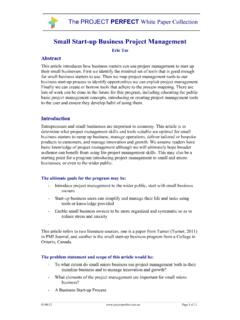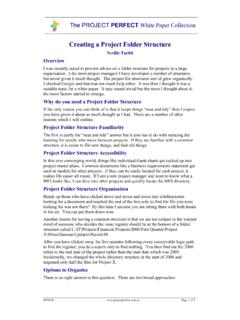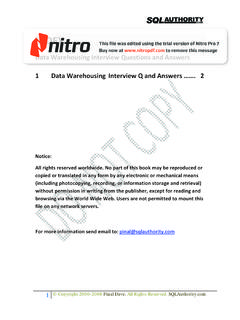Transcription of info service delivery - Project Perfect
1 The Project Perfect White Paper Collection 12/02/06 Page 1 of 6 service delivery Management Sandeep Mehta Purpose of this Article This article describes the scope and functions of service delivery Management. What does it mean? What do Global operations and account management mean. service delivery Model Communication Relationship Identifying Problems/ Providing Solution Planning 24 X 7 Support (Follow the Sun Approach?) Technology Implementation Quality Integration Customer Resources The Project Perfect White Paper Collection 12/02/06 Page 2 of 6 The above picture shows the service delivery Model, which can be applied irrespective of industry and/or technology. The author has derived this model from his experience and knowledge As indicated in the diagram above, in this model, there are: 4 Key areas 1. Customer 2. Resources 3.
2 Project 4. Program and 9 Sub areas 1. Communication 2. Relationship 3. Identifying Problems / Providing Solutions 4. Planning 5. 24 x 7 Support 6. Technology 7. Implementation 8. Quality 9. Integration Let us discuss the sub areas. The 4 key areas are at the heart of these 9 sub areas. They areas of Customer, Resources, Projects and Program are inter-woven through the sub areas. 1. Communication Communication is the most important aspect of the service delivery Manager (SDM). The responsibility of the SDM is to communicate with the Management, Resources, Project Managers and most importunately, the Client. The communication should be crisp, clear and unambiguous without leaving any doubt in the minds of the listener. It is not important how much volume of communication takes place but, it is of utmost importance to be timely, have the right context and it should spell out the value addition for the listener.
3 An SDM s time is very important and he or she cannot find the time to talk for hours. It is important that, they emphasises the important things in the best possible and prioritised ways. 2. Relationship A second name for an SDM is Account Manager . Of course, there will be another responsibility in the organisation known as, Business Development Manager, but it is less effective than the SDM. Clients see the SDM as, the primary contact for solutions and services . The SDM s phone is the first number, which is dialled by the client when they are facing any issues or problems. The Project Perfect White Paper Collection 12/02/06 Page 3 of 6 3. Identifying Problems/ Providing Solution To have a sound relationship requires an in-depth understanding of the client s requirements and domain. The SDM has to keep his or her attention focused on solving the client s problems and providing the client with a long lasting solution to run their business effectively and efficiently.
4 Over and above that, Relationship is also maintaining closeness with the client. This should result in the client being able to discuss any of his business requirements first with the SDM. Also when the SDM approaches the client with a proposal that can give competitive advantage to the customer, they will be eager to discuss the same. 4. Planning All the Project activities have to be planned. The schedule is discussed by the SDM with the customer. The Project manager is involved in the efforts required to estimate and execute the Project . Planning also involves defining the scope of the Project , constraints, assumptions, identifying associated risks, back-up plans, and resource planning. Once the Project starts, the Project Manager/lead will regularly send status reports to the SDM. He has to keep an eye on the progress and discuss with the PM from time to time about any constraints, assumptions and progress of the projects.
5 As far as possible, it should be transparent to the Customer. Any impact on the schedule should be discussed with the Customer and has to be agreed upon. The resources carrying out the Project should be well trained at least for the part of their responsibilities. The resources should be booked in advance to participate in the Project . Identifying good resources is a very important skill for the SDM. 5. 24 X 7 Support The 24 X 7 support for customer should be documented in a manual for processes and technical resolution of problems. There should be clear guidelines for assigning the priorities and taking actions. Assignment of priorities depends upon the criticality and impact of the problem. The escalation procedures should be clearly defined with Primary and Secondary backup persons and their contact numbers. The support personnel should be provided with laptops, VPN, mobile, pagers whatever is needed to service the calls from out of the office.
6 Appropriate automated ticketing system should be in place. This is also called a Customer Relationship Management (CRM) application. There could be the following three categories of tickets. a) Change requests b) Inquiry tickets, which may turn into change requests c) Incidence/Problem Management All the tickets should be tracked to closure and analysed for performance issues. The data is analysed using statistical techniques. A change ticket should carry a deployment/release plan for any RFC (Requirement for change) raised. Each ticket should contain the estimated time for completing the change, current status, action taken (work-log) and responsible person for resolving the issue. Estimation techniques should be in place to have error free estimation irrespective of The Project Perfect White Paper Collection 12/02/06 Page 4 of 6 who is doing the estimation.
7 The estimation model should be agreed with the customer, if necessary. Right testing procedures should be in place. The Development, UAT (User Acceptance Testing) environment should be in place along with the Production environment. The test data should be verified by the customer s representative prior to moving the change to Production. A suitable configuration tools should be in place to avoid loss of information. Follow the Sun Approach Not many companies adopt this approach for their support needs where support offices are located in three parts of the world ( US, EMEA and APAC). Each region provides 8 hours of support and hand-over to the next region. There has to be a proper handover report mentioning open issues, resolved issues and health of the system. There has to be at least half an hour of overlap on each side to ensure smooth transition to the next region.
8 Good communication is very important to ensure that, customer s issues are resolved without missing issues, and that someone is working on all the issues. 6. Technology The SDM should possess a skill set related to cutting edge technologies. Technology plays a vital part in the client s business, systems like business process management, ERP, supply chain, production planning, content management, business intelligence, enterprise application integration, CRM etc. To put in place a technology that works for the client, and which can deliver a high ROI is a challenging task. The idea is to feed the customer accurate information so as, not to lose information and also for the customer s management to be able to make business decisions on the spot. The SDM should keep himself or herself abreast of the latest trends in the IT world in order to bring value to the customer s business.
9 Upgrade and migration are the biggest Project active in today s world. The SDM should be in a position to suggest and work out the ROI for customer when various new options are offered in different area of technologies. Hence he or she should have the knowledge to support the same. 7. Implementation Implementation of new technology or any innovative idea demands a thorough execution. The SDM should be able to communicate the customer s priorities to the Project Manager. A lot of tools are available to plan, monitor and track the performance of projects. The Project manager chosen by the SDM should be able to execute the high-level guidelines and expectations. These guidelines are derived from the goals and objectives of the Project plan. The Project plan has to be approved by the SDM before the start of the implementation and changes thereafter also need approval.
10 For any go-live or roll out of application to production, a well-articulated plan should be in place. Any kind of failures or difficulties should be handled through a back out plan. System backups should be done regularly to recover from disasters. Disaster servers should be located at different physical location than the main servers. The Project Perfect White Paper Collection 12/02/06 Page 5 of 6 8. Quality For the service delivery Manager, quality is stated in terms of the Key Performance Indicators. The data related to the Project is measured and statistically analysed. For a support Project , it is termed service Line Agreements. Both SLA s and KPI s are discussed with customer and they agreed the numbers. Project Teams are made aware of these figures from the beginning to set the client s expectations and benchmarks. The actual data is measured, collated and compared with the benchmarks.






